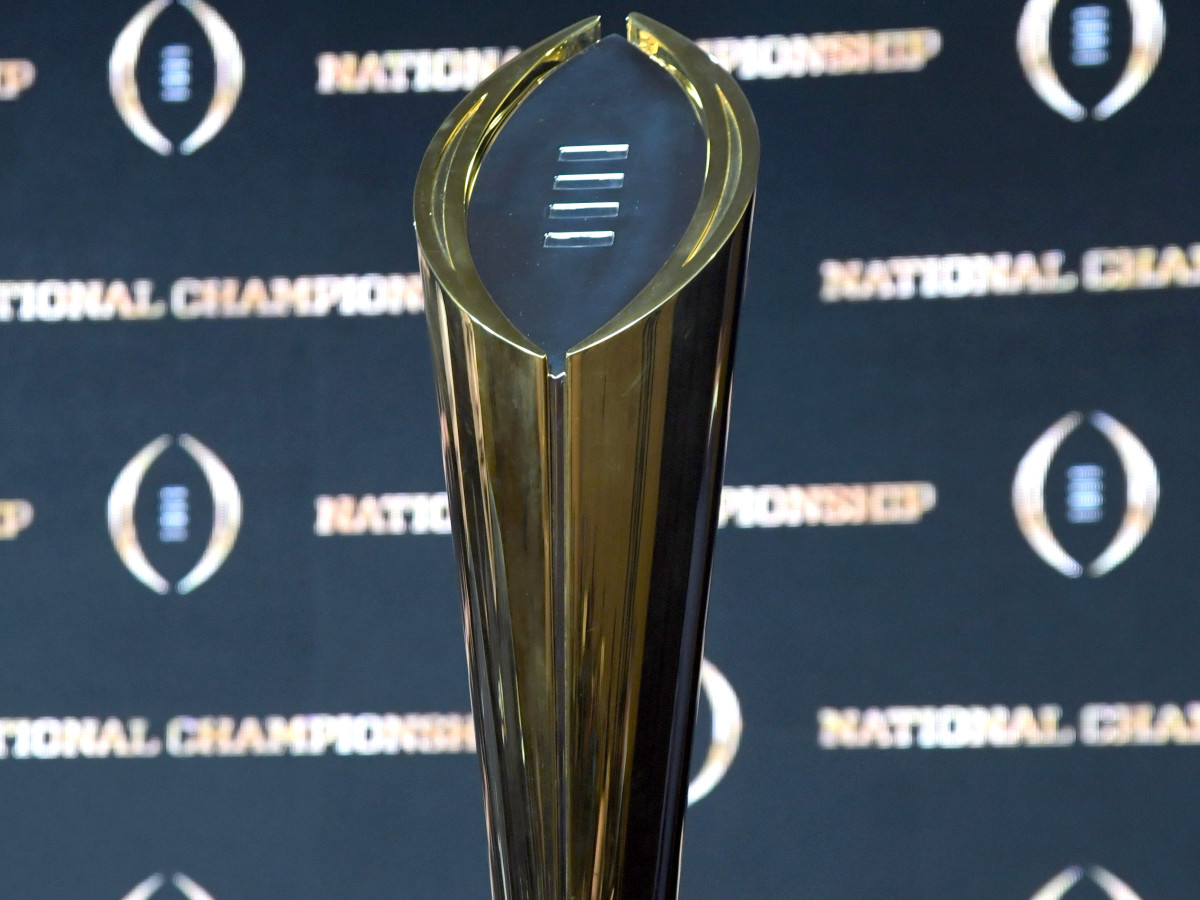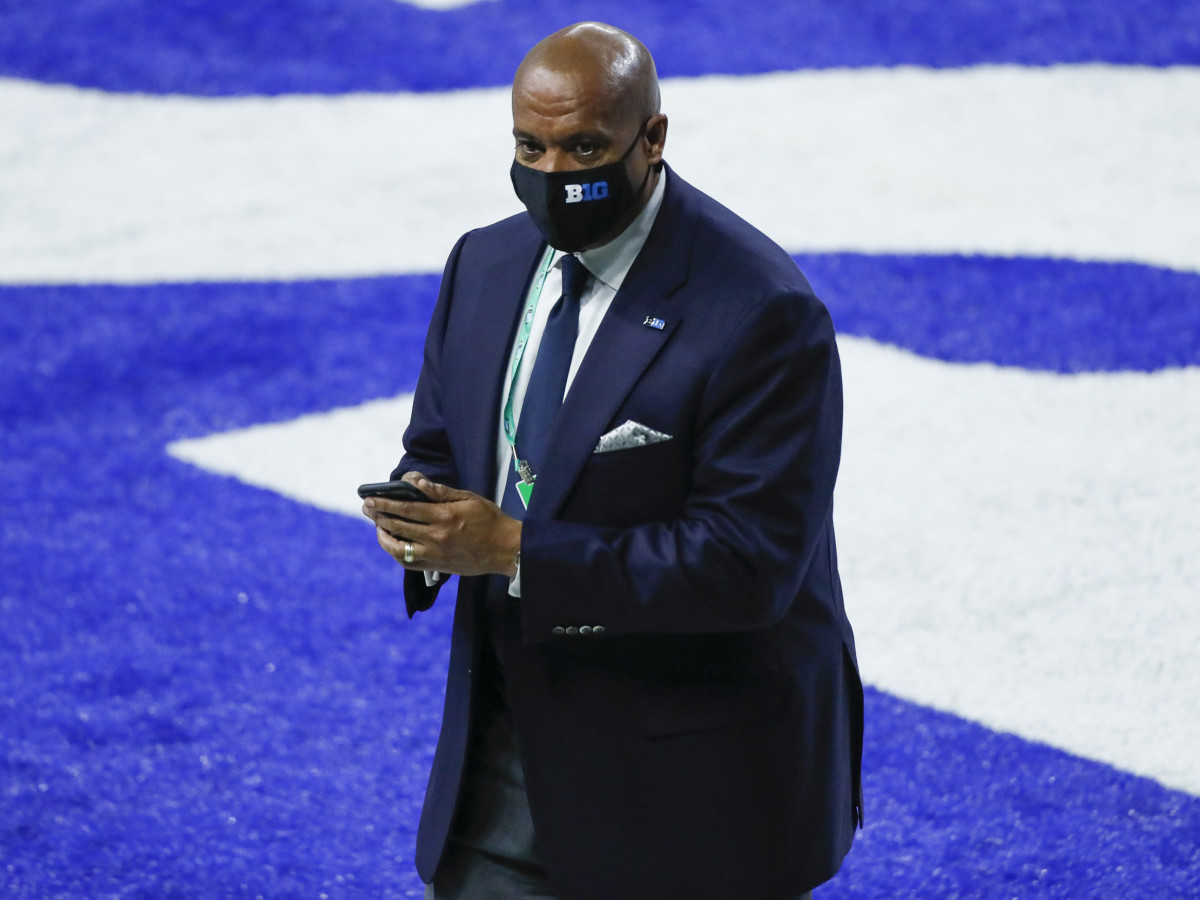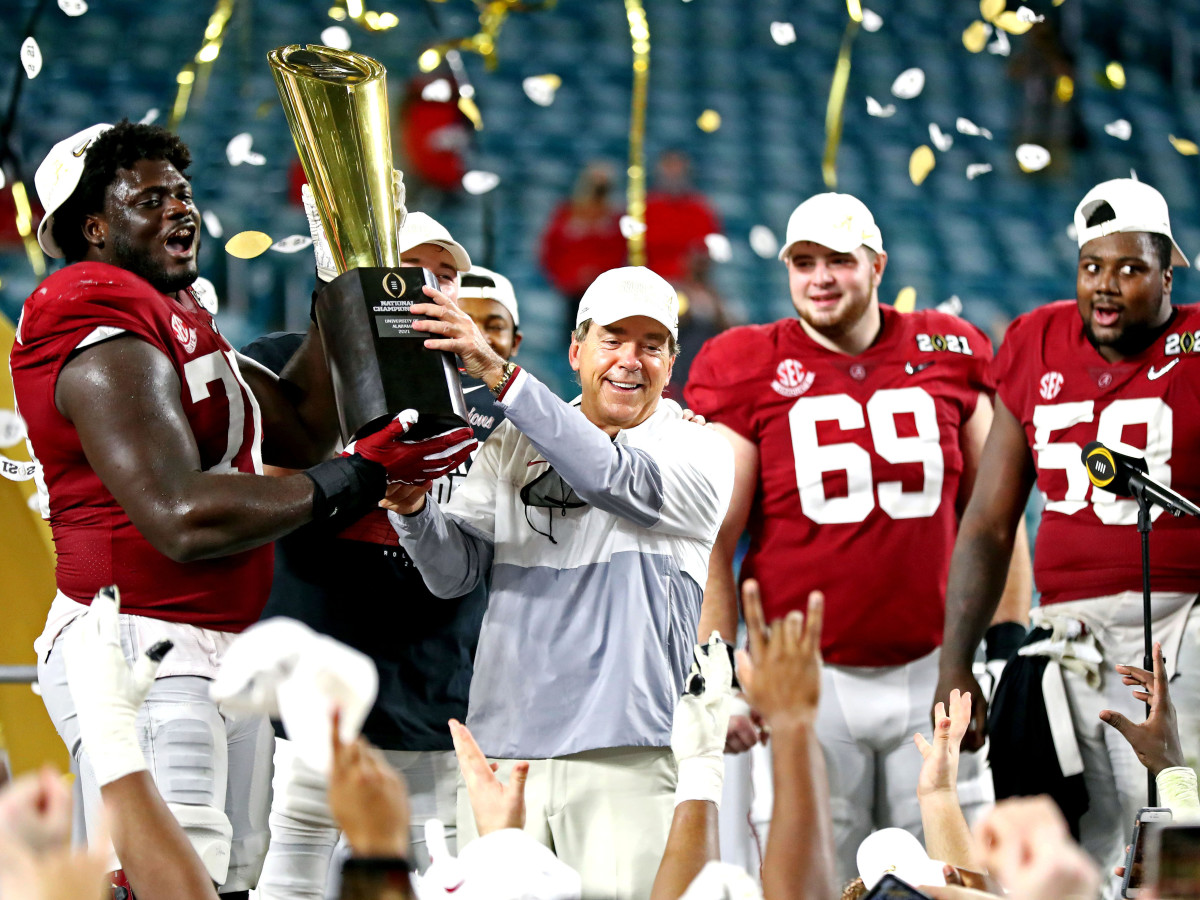Inside 27 Months of Playoff Expansion Discussions and the Arduous Path Ahead

Bill Hancock has been here before.
It’s not exactly déjà vu, but it’s close enough. To him, talk of expansion is old hat.
As the director of the NCAA Final Four, he experienced it. When will the men's NCAA tournament grow to more teams?! It expanded, of course, rising by one to 65 when he was director and then, years later, to 68.
As the executive director of the BCS, he found himself at the center of an annual expansion conversation. When will we have a playoff!? It expanded, of course, to the current four-team model.
Even dating back to his days at the Big Eight, Hancock has been around the topic (the Big Eight became, as you probably know, the Big 12).
And now, here in the spring of 2021, he’s back talking about—you guessed it—expansion. This time, there is no speculation or conspiracy theories. In fact, he himself sparked the latest expansion discussion, setting the college football world ablaze by releasing in a statement on April 23 that College Football Playoff decision-makers were exploring expansion models—a public unveiling of what many presumed is the logical next step.
“Did we take a risk by opening the curtain? I don’t think so,” says Hancock, the executive director of the CFP. “People need to know.”

Hancock only gave the people a taste of the ongoing discussion through three bits of information: (1) that a CFP working group is exploring models; (2) that those models range from a six- to a 16-team playoff; and (3) that the playoff will remain at four for at least the next two seasons.
There is much more, of course.
In fact, the playoff working group, made up of four members of the CFP Management Committee (the 10 FBS commissioners and Notre Dame AD Jack Swarbrick), has been exploring a new model for two years. The group, including commissioners Greg Sankey (SEC), Bob Bowlsby (Big 12) and Craig Thompson (Mountain West), as well as Swarbrick, was formed in January 2019 but paused to handle matters related to COVID-19 this past calendar year.
That said, the group is far enough along that several commissioners expect a presentation from the foursome at their next meeting in June, the first true step in the process of changing the model.
“I’m not about to predict the timing, but there is a general acknowledgement that the CFP will expand,” says one commissioner. “Is it going to happen? Yes. Will consensus around one model emerge quickly? I don’t know. There's a chance of that.”
In all, 10 of the 11 members of the CFP Management Committee spoke to Sports Illustrated for this story, some of them requesting anonymity and others speaking openly about only some aspects of the expansion conversation. They offered a more clear picture of the discussions—the potential timeline; possible formats; biggest hurdles; and, maybe most important of all, their personal feeling on expansion itself.
At least five committee members say they are pro expansion and another three are open to the idea. Their reasons include diversifying what’s recently been a field of the same teams, affording highly ranked mid-major programs an opportunity and giving a shot to more power programs.
Another two commissioners described themselves as undecided on expansion. None of them privately revealed they were against expanding, which bodes well for potential expansion since the biggest hurdle, most commissioners say, is arriving at unanimous agreement.
“There are 11 signatories to the [CFP] contract and everyone has to agree,” says Bowlsby, who declined to reveal specific formats discussed among the working group. “Reaching any unanimity with that many people with stakes in the game, it’s complex.”
It’s complex enough that Hancock insists that, at any one point in the steps to change the model, leaders could decide to keep the status quo. While a presentation in June seems likely, several commissioners tell SI that the committee has not discussed playoff expansion as a full group.
New ACC commissioner Jim Phillips says it is “premature” to assume the playoff will expand, and Thompson says the entire idea hasn’t been “vetted to any degree.”
Talks are so preliminary, Hancock says, that the CFP has not brought into the discussions TV and bowl partners—a key step in the process.
“Don’t read too much into it. Four teams remains an option,” says Hancock, often seen as a spokesperson for the two playoff governing bodies: the Management Committee and, above it, the Board of Managers, made up of 10 school presidents from each of the 10 FBS conferences plus Notre Dame’s leader. “This is due diligence.”
While the skepticism is understandable, the real story might be that the CFP is closer to expanding than ever before. The group hasn’t reached this point “if there’s not some significant interest in expanding,” says one commissioner.
This could be a long, arduous process, and yet it’s a journey that began more than two years ago. They seem to be in the final stretch.
“We’re ready to report out to our colleagues, in the first instance to the other commissioners and presidents,” says Swarbrick, the Notre Dame athletic director who sits on the expansion working group.
Swarbrick declined all questions regarding the working groups models, but he seemed to suggest that the most difficult work—pouring over dozens of formats and hundreds of data points—is mostly over. After all, they’ve been at it in secret now for 27 months.
After the Alabama-Clemson championship game to end the 2018 season, the group began to meet. They’d hold two-day meetings multiple times throughout the year and even met virtually during the pandemic. They’ve poured over extensive models, formats and stats. For instance, asks one commissioner, do you know what percentage of teams advance to their postseason championship event in an average NCAA sport?
The answer is about 18–25%. In football, that number is 3%.
“A football player has a statistically much lower chance of competing in a postseason tournament than any other athletes,” a committee member says. “That’s worth thinking about.”
Still, there’s a long way to go in what could be described as a three-step process to a playoff shakeup: (1) working group presents models; (2) Management Committee recommends a model to the CPF Board of Managers; and (3) the Board of Managers approves, amends or rejects the recommendation. The Board of Managers regularly meets twice a year: a teleconference in May and the day of the championship game.
Could the Board of Managers see a recommendation before January's title game in Indianapolis?
“Sure they can,” says one committee member.
To get there, some minds will need changing and the debate will rage.
Pac-12 commissioner Larry Scott and American commissioner Mike Aresco have been the most outspoken champions of expansion, while Sankey has been the most public in support of the current model. In no coincidence, Scott and Aresco’s leagues have combined to qualify zero teams in the playoff the last four years. In the same time frame, schools from Sankey’s conference have won three titles and played in a cumulative 10 playoff games.
Sankey says he remains in the same place he’s always been.
“Four has worked, is working and can work moving forward,” he says.
When asked directly if he’s against expansion, he says he doesn’t hold a position and is on the working group to listen.
“I respect the diversity of opinions,” he says.
The opinions are steadily changing as new faces arrive. Scott, for instance, is stepping down this summer. His replacement hasn’t yet been named. Phillips just started this spring. Big Ten commissioner Kevin Warren took over last year, and Sun Belt commissioner Keith Gill was hired in 2019.

Despite eight of the 11 saying they are in favor of expansion or at least open to it, there are varying opinions on how to expand. There are five key questions:
How many teams are involved? When, in an already tight schedule, do you play the extra round or rounds of games? Where will the new round or rounds of games be played? Does the format include automatic qualifiers and who gets them? What are the unintended consequences, such as a further diminishing of the bowl system and safety concerns of players competing in more games?
“Believe me,” says one league commissioner, “it’s going to be controversial.”
An accord seems to exist among most of the group on at least one of those questions: Early-round games should be hosted on campus by the top seeds.
Among commissioners, a key concern in expansion is weakening what is one of sports’ most thrilling regular seasons. In a playoff with on-campus games, teams are not just playing to get into the playoff field, but they are playing to host, incentivizing late-season matchups and then delivering titanic playoff duels in a more traditional college setting.
“How would you like to see Alabama travel to Ohio State for a playoff game?” asks one committee member. “Or Clemson hosting Oklahoma?”
There is less agreement on the most essential of questions: How many teams are involved?
“I think eight to 12 teams is the sweet spot,” says another commissioner.
Two more believe eight is the ideal number and another said “six to eight” is appropriate. Most, though, are reserving judgement on the topic. This issue could see the most debate, as well as the fight over automatic qualifiers.
Several commissioners, even one from the Group of Five, believe that each Power 5 champion and the highest ranked team from the Group of Five should receive an automatic berth. An automatic spot for a G5 team is viewed as an essential compromise, as five of the 11 members represent G5 leagues.
The conversation then turns to the number of at-large teams, which, under the six-team automatic qualifying model, could range from zero (a six-team playoff) to eight (a 16-team playoff). An eight-team playoff under the AQ model would include just two at-large teams. At least one conference commissioner believes that to be too few.
But going beyond eight teams means adding a new round of the playoff. In a 10–16 team model, a program that participates in the first round of games and advances to the title game would have played four playoff games in addition to 12 regular season games plus a conference championship game for a total of 17.
“Biggest thing for me is we need to be methodical in our approach for any CFP expansion,” says Warren. “We need to take a holistic approach and continue to keep the well being of the student athletes at the center.”
The schedule is another tricky matter. Adding one round of games in mid-December is easy, wedging it between the conference championship weekend and the traditional semifinals around New Year’s Eve. Adding a second round of games is much more complicated.
Shrinking the regular season is nearly a non-starter, at least three commissioners say. Moving the entire schedule up a week—everyone plays on Week 0—is an option, though not attractive. Conference title games would bump to Thanksgiving weekend, the traditional date of intra-conference and cross-conference rivalry matchups.
Moving back the title game to mid-January is a possibility too, though that could encroach on the start of the second semester, while also pitting college playoff games against the NFL postseason. The NFL expanded its regular season to add a game this past year, tossing a wrench into the CFP working group’s discussions. The 2022 NFL playoffs now begin Jan. 15–16.
“The schedule is the biggest variable and maybe the most challenging,” says one committee member.
Other commissioners say the most complex issue is the CFP restructuring seven different contracts, each running through 2025. The organization is seven years into a 12-year deal with television partner ESPN, as well as individual 12-year contracts with the six marquee bowls: Rose, Fiesta, Sugar, Peach, Orange and Cotton. The historic connections between those bowls and individual conferences make restructuring a difficult endeavor, some commissioners say.
But not all agree.
In fact, rather than allowing the deal to expire and taking a new playoff model to the open market, the CFP restructuring mid-contract is beneficial for ESPN and the bowls. The ball, so to speak, is in their court.
“I don’t think ESPN or the bowls would mind it,” says one commissioner. “They’d be licking their chops. It’s an opportunity for them to secure their position.”
As part of the CFP agreements, revenue is distributed unequally. Of the $462 million in revenue from the 2019 playoff, $366 million went to the Power 5 and Notre Dame. Just $91 million went to the Group of Five, and roughly $4 million was split among FCS independents and the FCS.
The Group of Five will likely have more regular participation in any new playoff, and thus G5 executives want a bigger cut of the pie.
Another side effect of an expanded playoff: further diminishing a bowl system that many in college athletics feel will drift closer to irrelevancy with each additional playoff participant. While those at the upper echelon of the FBS are focused on the playoff, there are dozens of others whose realistic goal is a bowl.
After all, there are 130 FBS programs.
“College football needs bowl games,” says Nick Carparelli, the executive director of Bowl Season, an organization with a mission of advancing and supporting the 42 bowl games. “The conversations I’ve had with the commissioners have been very encouraging. I think they appreciate and need the bowl system.”
The bowls, though, are in a precarious position. The financial crunch of COVID-19 has left many in limbo and the trend of players opting out of bowls has further impacted the games. Over the next two years, Carparelli is engaging with college athletics' leaders, he says, to “work together on what the next evolution of college football's postseason is—both the playoff and the bowls.”
From administrators to even coaches, college leaders say the bowl system has a place in college sports. But to what extent?

Alabama coach Nick Saban recently expressed concern of how a playoff expansion would lead to a continuation of a trend where “the bowl games become less and less significant.”
“Maybe these two things can’t coexist,” he said of the bowls and playoff.
And what about the regular season? For years, college athletic leaders have championed their regular season as the best in any American sport. During the BCS era, leaders would claim that college football’s playoffs were embedded in regular season affairs and that quasi-semifinals played out during conference championship weekend.
There is concern among commissioners of ruining that.
“You can already see this has become a regular season that’s about the playoff,” says one, “and I don’t know if that’s good.”
Even those who would benefit from an expanded playoff have concerns. Jamey Chadwell, head coach at Coastal Carolina, had what could have been a Group of Five playoff team last season. And yet still, he’s worried about what expansion would mean for the regular season. The Chanticleers played BYU in one of the most exciting and anticipated games of last season that was hastily scheduled just days in advance.
“Let’s say we go to 16 teams. We are in and BYU is in and that game doesn’t mean as much,” he says.
However, he and others understand the desire for more teams—a diversifying of a field that’s gone stale. Eleven teams have participated in the seven playoffs. Of the 28 selections, 20 of them have gone to four teams: Alabama (six), Clemson (six), Oklahoma (four) and Ohio State (four). That’s 71% of playoff slots to a quad of teams in a college football landscape that contains 130 total teams and 65 in the Power 5.
“That’s why people want expansion,” Chadwell says. “It’s probably going to be the same teams in there, but at least you have some chances to get others in.”
And so here we are. College athletic administrators expect expansion to be an agenda item during conference spring meetings later this month. In fact, Hancock is scheduled to appear at a spring college football summit in Phoenix this week. He’s on a panel to discuss how the CFP selection committee assigns teams to the New Year’s Six bowl games.
He knows another topic will likely pop up—one in which he’s very familiar: expansion. It’s like the déjà vu of déjà vu.
“I wouldn't be overly surprised if we ended up with four. We may not find agreement,” says one CFP committee member.
Seconds later, the same person relented to what many believe is the truth. “At the end of the day, I think there will be expansion.”
More From Ross Dellenger:
